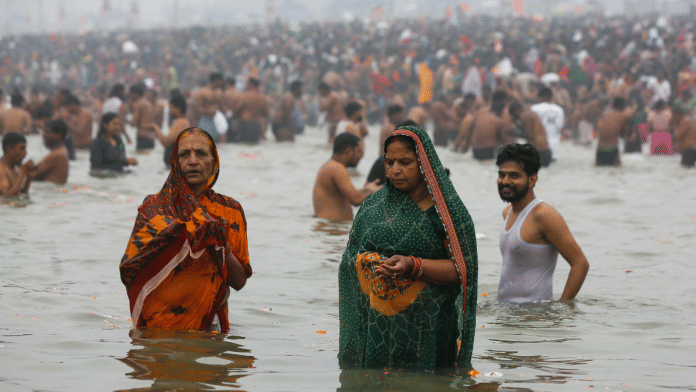The unprecedented crowd at the Maha Kumbh Mela in Prayagraj, which concluded last week, garnered significant public attention. As per the estimate of the Uttar Pradesh Police, nearly 65 core people visited Prayagraj until 25 February. This event also led to a surge in footfall in Ayodhya and Varanasi, with Maha Kumbh devotees visiting these cities later. Earlier, those going to Ayodhya would also visit Varanasi and Prayagraj.
Numerous studies can be conducted on the political, sociological, and psychological dimensions of the crowd visiting these places. However, there is also an economic dimension that needs significant attention. The rise of religious pilgrimage can potentially develop Ayodhya, Kashi, and Prayagraj.
I briefly examine the growing significance of religious tourism in economic development and how the Uttar Pradesh government can better utilise religious sites in eastern UP for developing the region. The development of religious tourism has the potential to economically uplift poverty-ridden eastern UP, provided the government shifts its attention toward under-utilised Buddhist religious sites.
Also read: Vedas don’t mention Hindu pilgrimages. When did they become mainstream?
Religious tourism and economic development
Tourism plays a crucial role in keeping the global economy flourishing. Its influence on the economy goes beyond generating revenue and jobs. It acts as a catalyst for growth, encouraging investment in infrastructure, supporting sustainable development, and promoting the preservation of cultural and natural heritage. It particularly provides developing nations the opportunity to diversify their export revenues.
Among the various types of tourism, faith-based travel, such as pilgrimages, is one of the oldest. And it has grown worldwide in different forms due to the increasing interest in spirituality and cultural exchange as a result of globalisation and technological advancement.
Being the oldest civilisation, India has always attracted tourists, and Uttar Pradesh has been the special beneficiary due to the Taj Mahal in Agra. However, of late, the growing Indian diaspora has increased the significance of religious tourism in the country. Once again, by being home to many religious sites, Uttar Pradesh is benefiting the most.
Ayodhya, Kashi, Prayagraj
Religious tourism is growing in Ayodhya, Kashi, and Prayagraj, given the rich spiritual legacies of these cities. The Indian government’s efforts to promote religious tourism by upgrading infrastructure—like roads, airports, and accommodations—have made these cities more accessible to pilgrims. The Uttar Pradesh government reportedly allocated Rs 7,500 crore for the Maha Kumbh, and Chief Minister Yogi Adityanath said the event would bring more than Rs 3 lakh crore to Uttar Pradesh’s economy.
The projected economic growth of Uttar Pradesh due to the Maha Kumbh can have a positive impact on the impoverished eastern UP and Awadh regions, where successive governments have failed to bring industries that can generate employment. However, the growing religious tourism in the state offers a ray of hope that eastern UP can become a hub for an employment-generating tourism industry.
Also read: Inside Elite Kumbh—no crowds, no chaos, only VIP Sangam, 5-star spirituality
Buddhist sites in eastern UP
Awadh and eastern Uttar Pradesh are witnessing the rise of religious tourism due to Ayodhya and Varanasi. These sites are likely to benefit neighbouring districts in a few months. However, to fully realise the potential of these regions, the government needs to focus on developing sacred sites of Buddhism. The Terai belt and eastern Uttar Pradesh have sites like Kapilvastu, Shravasti, Kushi Nagar, and Sarnath. However, the governments have been unable to utilise these sacred sites for religious tourism. The Mayawati government in Uttar Pradesh gave recognition to these places by making them districts, but that effort lacked the required economic investment.
Having visited Kapilvastu and Shravasti, it surprised me to see the underutilisation of places that have huge potential to attract foreign tourists. One can hardly find proper shops near the Piprahwa stupa in Kapilvastu, where the sacred relics of Buddha were found in 1898, encouraging the excavation of remaining Buddhist sites in India.
Despite gaining wide scholarly attention in the global academia, the site lies in a state of neglect.
China’s wake-up call to India
The Indian government has recently turned its attention to the country’s Buddhist heritage. It was evident in the 2025 Republic Day parade, which was dominated by tableaux themed on Buddha and Buddhism. One reason for that could be the presence of leaders from 10 ASEAN countries.
However, since 2023, the Modi government has been organising the Global Buddhist Summit in collaboration with the International Buddhist Confederation. The Union government’s step seems to be a response to China’s ambitions to harness Buddhist soft power for influence in Buddhist-majority countries. As a result, Buddhism has become part of a broader soft power rivalry between India and China for regional influence in Asia. While the Indian government has started providing the highest pedestal to Buddhism on the global stage, it has yet to pay attention to preserving and promoting historical Buddhist sites in eastern Uttar Pradesh. Even the Nepal government has started developing significant Buddhist sites such as Ramgram and Devdaha.
The unprecedented crowd at the Maha Kumbh signifies the growth of religious tourism in eastern Uttar Pradesh, which lacks industries that can create jobs. However, the growth of a sustainable tourism industry requires the development of Buddhist religious sites. Such development will not only be beneficial for the economic growth of the state but also for the country’s diplomacy.
Arvind Kumar is a Visiting Lecturer in Politics & International Relations at the University of Hertfordshire, UK. He tweets @arvind_kumar__. Views are personal.
(Edited by Aamaan Alam Khan)






